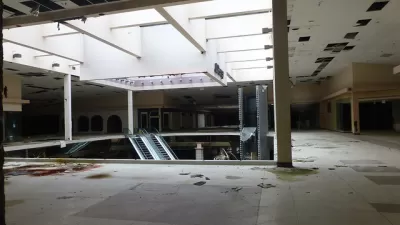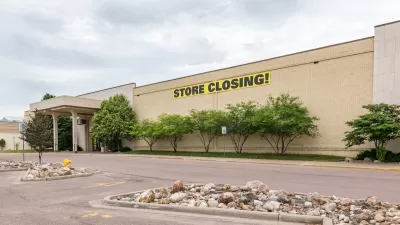Stephanie Clifford documents the extraordinary lengths malls across the country are going to in hopes of attracting customers in the face of e-commerce and a battered economy.
Victor Gruen probably didn't have vegetable gardens and casinos in mind when he envisioned the country's first enclosed shopping malls as community centers. But in communities across the country who cannot afford to demolish malls suffering from high vacancy levels or attract new tenants, some extraordinary uses are bringing in visitors. According to Clifford, "Schools, medical clinics, call centers, government offices and even churches are now standard tenants in malls."
"The efforts reflect a shift in how Americans want to shop today: rather than going to big, overwhelming malls, many prefer places where stores can be entered from the street, featuring restaurants, entertainment and other Main Street mainstays. Also, as commuters in urban areas shift to public transportation, the giant parking lots are no longer needed."
"While some malls can afford to change with the times, many cannot, and over all, there are too many malls today, urban planners say. The vacancy rate at shopping centers and strip malls was 11 percent in the last quarter of 2011, the highest level since 1991, according to the research firm Reis. Larger regional malls fared better, with a vacancy rate of 9.2 percent."
FULL STORY: How About Gardening or Golfing at the Mall?

Planetizen Federal Action Tracker
A weekly monitor of how Trump’s orders and actions are impacting planners and planning in America.

Congressman Proposes Bill to Rename DC Metro “Trump Train”
The Make Autorail Great Again Act would withhold federal funding to the system until the Washington Metropolitan Area Transit Authority (WMATA), rebrands as the Washington Metropolitan Authority for Greater Access (WMAGA).

The Simple Legislative Tool Transforming Vacant Downtowns
In California, Michigan and Georgia, an easy win is bringing dollars — and delight — back to city centers.

The States Losing Rural Delivery Rooms at an Alarming Pace
In some states, as few as 9% of rural hospitals still deliver babies. As a result, rising pre-term births, no adequate pre-term care and harrowing close calls are a growing reality.

The Small South Asian Republic Going all in on EVs
Thanks to one simple policy change less than five years ago, 65% of new cars in this Himalayan country are now electric.

DC Backpedals on Bike Lane Protection, Swaps Barriers for Paint
Citing aesthetic concerns, the city is removing the concrete barriers and flexposts that once separated Arizona Avenue cyclists from motor vehicles.
Urban Design for Planners 1: Software Tools
This six-course series explores essential urban design concepts using open source software and equips planners with the tools they need to participate fully in the urban design process.
Planning for Universal Design
Learn the tools for implementing Universal Design in planning regulations.
Smith Gee Studio
City of Charlotte
City of Camden Redevelopment Agency
City of Astoria
Transportation Research & Education Center (TREC) at Portland State University
US High Speed Rail Association
City of Camden Redevelopment Agency
Municipality of Princeton (NJ)





























